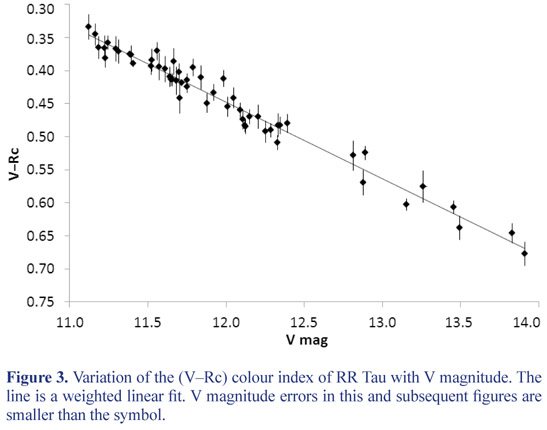Photometry & spectrophotometry of the Herbig Ae star RR Tauri
2019 July 26
Abstract
Multicolour broadband photometry and flux-calibrated low-resolution spectroscopy, obtained between 2014 & 2018, are used to investigate the behaviour of the highly variable Herbig Ae star RR Tauri. As the star experienced a deep Algol-like fade in flux by a factor of over 10, we found the change in spectral continuum to be ‘grey’ while Hα emission flux halved. We also observed the (V–Rc) colour index reddening as the star faded, suggesting emission detectable in the Rc-band but beyond our spectral response. We confirm that the circumstellar reddening of RR Tau is consistent with an extinction ratio Rv= 5, and that its spectral type is close to A0. According to its luminosity and temperature RR Tau is located in the H-R diagram among other HAEBE stars, contracting onto the Zero Age Main Sequence, with a mass between 4 & 5 solar masses.
What we know about RR Tau
 The star now known as RR Tau was first discovered to be variable by Lydia Ceraski in 1900, on photographic plates taken at Moscow Observatory. Merrill & Burwell (1950) reported the star as having a bright Hα emission line in objective prism photographs taken at Mt Wilson. Herbig (1960) included RR Tau as one of 26 stars with spectral type Ae or Be associated with nebulosity (the ‘e’ denoting the presence of emission lines in their spectra), which he predicted were still contracting to the main sequence. These stars have come to be known as Herbig Ae/Be (or HAEBE) stars and have masses in the range 2–8 solar masses. Herbig reported RR Tau as varying irregularly between magnitude 10.2 & 14.2. Herbig’s conjecture that HAEBE stars were young was confirmed by Strom et al. (1972), who showed that they are pre-main sequence stars surrounded by circumstellar dust.
The star now known as RR Tau was first discovered to be variable by Lydia Ceraski in 1900, on photographic plates taken at Moscow Observatory. Merrill & Burwell (1950) reported the star as having a bright Hα emission line in objective prism photographs taken at Mt Wilson. Herbig (1960) included RR Tau as one of 26 stars with spectral type Ae or Be associated with nebulosity (the ‘e’ denoting the presence of emission lines in their spectra), which he predicted were still contracting to the main sequence. These stars have come to be known as Herbig Ae/Be (or HAEBE) stars and have masses in the range 2–8 solar masses. Herbig reported RR Tau as varying irregularly between magnitude 10.2 & 14.2. Herbig’s conjecture that HAEBE stars were young was confirmed by Strom et al. (1972), who showed that they are pre-main sequence stars surrounded by circumstellar dust.
Over the following years many authors discussed the nature of HAEBE stars, and RR Tau in particular. Among others, these include Grinin (1988), Catala (1989), Grinin (1994), Rostropchina et al. (1997), Grinin (2001), Rodgers et al. (2002), Hernandez et al. (2004), Mendigutia et al. (2011), and references therein. A general consensus emerged that these stars are surrounded by a protoplanetary disc seen almost edge-on, containing opaque clouds which orbit the star within the disc. Variable obscuration by these clouds is believed to be the cause of the irregular changes and occasional deep Algol-like minima seen in the lightcurves. In addition, they emit a stellar wind which generates emission lines in a circumstellar shell of gas and dust. This shell contains larger dust grains than occur in the interstellar medium and strongly reddens light emerging from the star. According to this model, the star’s brightest state represents its intrinsic luminosity.
However, not everyone followed this hypothesis. Herbst & Shevchenko (1999) argued that the brightness changes may be due to variable accretion from circumstellar material. In their model, fades are caused by a drop in accretion rate so the true luminosity of the star is seen at minimum light. It may be that a combination of variable obscuration and variable accretion mechanisms will be necessary to fully explain the observed behaviour of RR Tau….
Photometric observations
V and Rc filtered images of RR Tau were recorded using a 0.35m Schmidt-Cassegrain telescope on 53 nights, during four observing seasons between 2014 December & 2018 March. A small number of B-filtered images were also obtained during 2018. All images were dark-subtracted and flat-fielded, before magnitudes were determined by differential photometry with respect to an ensemble of three nearby comparison stars; these were selected from the AAVSO chart for RR Tau….
Over the period RR Tau’s V magnitude varied erratically between 11.12 & 13.91, as shown in Figure 2. Between 2016 Mar 14 & April 12 the star experienced a deep Algol-like fade, when its magnitude dropped from V= 11.16 to V= 13.91: a factor of 12.6 in flux. This occurred immediately before the star was lost at the end of the 2016 observing season. Figure 3 shows that the (V–Rc) colour index reddened as the star faded, changing from 0.35 at its brightest to 0.68 at its faintest….
Spectroscopic observations
We recorded low resolution (5Å, where 1Å= 10–10m) spectra of RR Tau, between 4000 & 7000Å, on 14 nights with a LISA spectrograph on a 0.28m Schmidt-Cassegrain telescope. The times of these spectra are marked in Figure 2. Spectra were bias and dark-subtracted, flat-fielded and wavelength-calibrated using the spectrograph’s internal Ar-Ne lamp. They were then corrected for instrumental and atmospheric response using spectra of an A-type star with a known spectral profile, located at the same air mass as RR Tau and recorded immediately prior to the RR Tau spectra. Finally, spectra were flux-calibrated by scaling the V-band flux using a V magnitude measured concurrently with the spectra…. (continued)(Login or click above to view the full illustrated article in PDF format)
| The British Astronomical Association supports amateur astronomers around the UK and the rest of the world. Find out more about the BAA or join us. |
